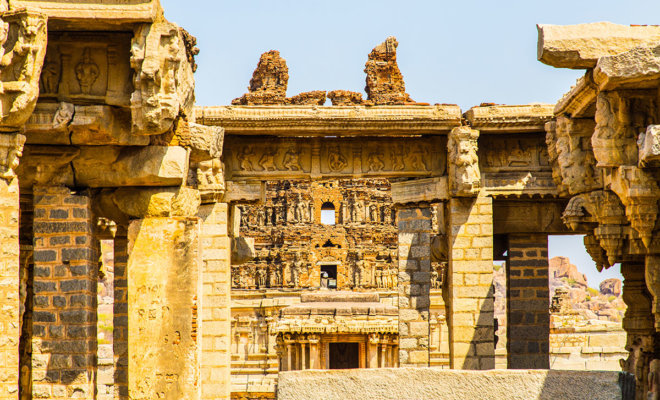Arts
India is on the Hunt for 24 ‘Untraceable’ Historical Treasures

Ruins of Hampi.
Photo: Bigstock
Some monuments are missing because of inadequate or antiquated record-keeping; others have physically disappeared, destroyed by natural disasters or by humans.
The ancient temple of Kutumbari stood for centuries in Dwarahat in north India. Then one day in the 1960s, officials realized it had vanished from records – and later discovered it had disappeared altogether.
The Kutumbari is one of 24 monuments on a list of now “untraceable” protected monuments in India. Some have gone missing because of inadequate or antiquated record-keeping; others have physically disappeared, destroyed by natural disasters or by humans.
After repeated calls by Indian parliamentarians to locate lost monuments, the Archaeological Survey of India (ASI), the government agency responsible for the conservation of heritage buildings and artifacts, instructed its local affiliates to redouble efforts to find a cache of missing antiquities that includes medieval tombs, inscribed tablets and temples. Some of the items on the list have been lost for decades.
The search revived concerns from historians and archaeologists about whether India’s centuries-old historical treasures are being protected as the country chases development targets.
As India’s fortunes rise, a poorly staffed bureaucracy has overseen decades of growth. Successive leaders, including Prime Minister Narendra Modi, stressed the need for new roads, housing and infrastructure to keep pace with the growing population’s needs.
But with the emphasis on rapid development, hundreds of India’s ancient monuments, and with them millennia of history, could be lost, damaged or degraded.
“We have lost sight of the value of these things,” said Swapna Liddle, convener of the Delhi chapter of the Indian National Trust for Art and Cultural Heritage.
With local authorities and private companies racing to develop land, Liddle said, protected areas surrounding monuments are increasingly valuable. Monuments can get in the way of plans to construct new metro lines, roads and housing developments.
“What we have to ask ourselves is, are we going to sacrifice our heritage for development goals?” she said.
The list of untraceable monuments, Liddle said, points to a wider problem in heritage conservation in India: Monuments that aren’t major tourist attractions are more likely to fall into disrepair.
Many monuments are not properly labeled, so locals are unaware of their historical significance, Liddle said. Often, monuments are left completely unguarded, which leads to encroachment or squatting by locals.
On Jan. 2, India’s lower house in Parliament passed legislation that would weaken restrictions on construction in the area surrounding historical monuments. Members of Parliament opposing the bill said the new legislation put at risk the conservation and aesthetics of centuries-old monuments.
“Historic monuments and archaeological sites are the symbols of our traditional and cultural heritage,” N.K. Premachandran of Kollam said during a parliamentary session. “They are invaluable treasures of our nation which cannot be explained or weighed in monetary terms.”
The proposed amendments have yet to be passed by the upper house.
Meanwhile, decades of neglect have already led to the loss of dozens of archaeological treasures. According to ASI Director Devkinandan Dimri, a number of protected monuments have been submerged underwater over the years, while others have been lost to rapid urbanization.
But the list of 24 untraceable items, Dimri said, is imperfect. It was drawn from a colonial-era list of all the monuments on the ASI’s roster. Some items on it, such as a 12th-century temple in the western state of Rajasthan, may never have existed or may be part of another temple in the area.
Others, Dimri said, were identified in records before geolocation, and so exact locations are difficult to pinpoint. In some cases, villages or towns have changed names and property has changed hands. In others, monuments may have been moved by locals.
“Our field offices are working very hard to find out what they can,” he said. “We have all the records. We believe some of the sites are still there but that we can’t locate it for several reasons.”
What happened to the Kutumbari? Over the years, at least two fact-finding teams have tried to find out. Dimri said the temple was probably destroyed by a flood or natural disaster in the 1950s and that stones from the old building had been reused by locals to build homes.
“I went there myself once,” he said. “I asked an old lady who told me a temple existed once but that it was not there. She did not know where it had gone.”
© 2018 The Washington Post

You must be logged in to post a comment Login